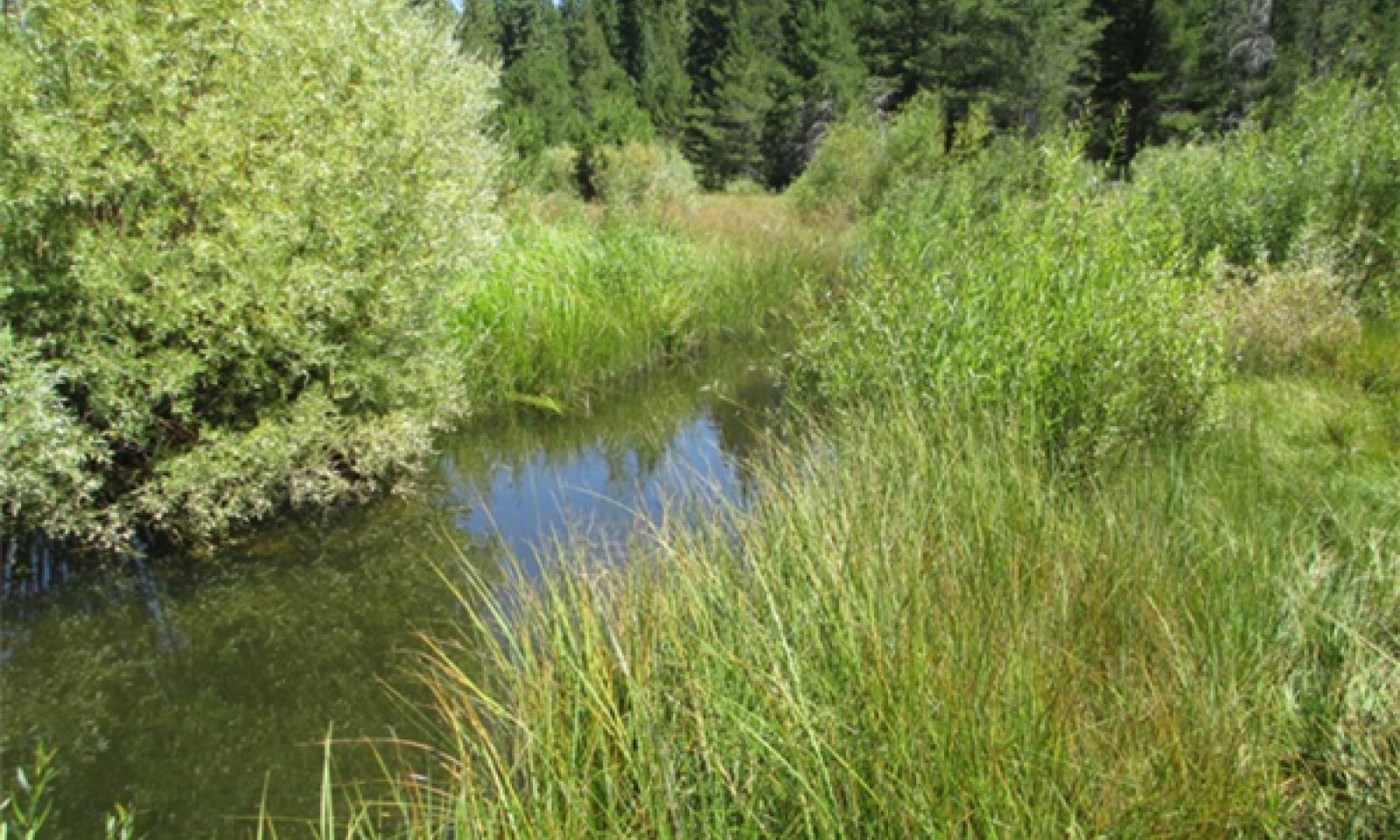

Natural Resources
Conservation Service
Ecological site R022AX102CA
Frigid E-C Meadow System
Accessed: 11/21/2024
General information
Provisional. A provisional ecological site description has undergone quality control and quality assurance review. It contains a working state and transition model and enough information to identify the ecological site.
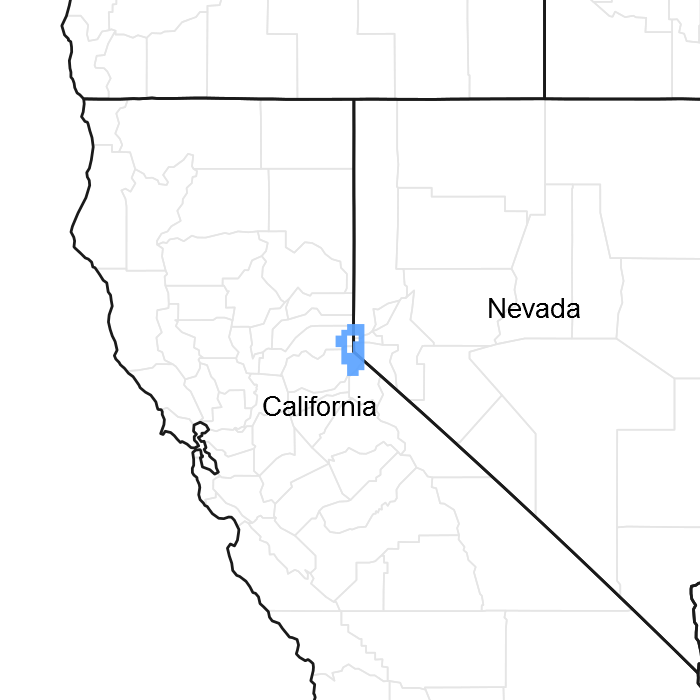
Figure 1. Mapped extent
Areas shown in blue indicate the maximum mapped extent of this ecological site. Other ecological sites likely occur within the highlighted areas. It is also possible for this ecological site to occur outside of highlighted areas if detailed soil survey has not been completed or recently updated.
MLRA notes
Major Land Resource Area (MLRA): 022A–Sierra Nevada and Tehachapi Mountains
Major Land Resource Area 22A, Sierra Nevada Mountains, is located predominantly in California and a small section of western Nevada. The area lies completely within the Sierra Nevada Section of the Cascade-Sierra Mountains Province. The Sierra Nevada range has a gentle western slope, and a very abrupt eastern slope. The Sierra Nevada consists of hilly to steep mountains and occasional flatter mountain valleys. Elevation ranges between 1,500 and 9,000 ft throughout most of the range, but peaks often exceed 12,000 ft. The highest point in the continental US occurs in this MLRA (Mount Whitney, 14,494 ft). Most of the Sierra Nevada is dominated by granitic rock of the Mesozoic age, known as the Sierra Nevada Batholith. The northern half is flanked on the west by a metamorphic belt, which consists of highly metamorphosed sedimentary and volcanic rocks. Additionally, glacial activity of the Pleistocene has played a major role in shaping Sierra Nevada features, including cirques, arêtes, and glacial deposits and moraines. Average annual precipitation ranges from 20 to 80 inches in most of the area, with increases along elevational and south-north gradients. Soil temperature regime ranges from mesic, frigid, and cryic. Due to the extreme elevational range found within this MLRA, Land Resource Units (LRUs) were designated to group the MLRA into similar land units.
LRU “X” represents ecological sites driven by abiotic features that override the typical soils or climatic features that drive most of the other LRU zones. In the Sierra Nevada these sites are typically driven by water features associated with lotic or lentic riparian systems. Other features maybe shallow bedrock, or unique chemical development which affects the growth of typical vegetation.
Ecological site concept
This riparian complex is associated with alluvial valley types (VIII) at elevations typically between 6,200 and 7,500 feet, with a reference E or C channel type (Rosgen 1996). The majority of this site presently has an F channel type. Several community components are present in relation to soils, depth to water table, and flood disturbance. Common species are Lemmon’s willow (Salix lemmonii), Geyer willow (Salix geyeriana), Northwest Territory sedge (Carex utriculata), Nebraska sedge (Carex nebrascensis), and tufted hairgrass (Deschampsia cespitosa). North American beaver (Castor canadensis) can influence the channel morphology with construction of dams, which pond and divert flow. The dominant soils formed in very deep alluvium, and have few rock fragments and a coarse loamy particle size class. They have a deep, rich surface often with buried layers in the lower horizons from past flood events.
Associated sites
| F022AE007CA |
Frigid, Sandy, Moraines And Hill Slopes This ecological site occurs on moraines and mountain slopes, primarily formed in granitic parent material. A white fir (Abies concolor) mixed conifer forest is present. |
|---|---|
| F022AE013CA |
Frigid, Loamy, Volcanic Mountain Slopes This ecological site occurs on volcanic mountain slopes, with white fir (Abies concolor) mixed conifer forests present. |
| F022AF001CA |
Frigid Sandy Outwash Plain Gentle Slopes This ecological site occurs on gently sloped outwash, which has a layer of cemented till, which impedes water flow. Western juniper (Juniperus grandis) and Sierra lodgepole pine (Pinus contorta var. murrayana) are present. |
| F022AF002CA |
Frigid, Sandy, Or Loamy Outwash This ecological site occur on gently sloping outwash. Jeffrey pine (Pinus jeffreyi) forest dominate, with antelope bitterbrush (Purshia tridentata) and mountain sagebrush (Artemisia tridentata var. vaseyana) common. |
| F022AF004CA |
Frigid, Shallow To Deep, Sandy Mountain Slopes This site typically occurs on south facing, granitic mountain slopes with moderately deep to deep soils. An open forest of Jeffrey pine (Pinus jeffreyi) is present with an understory of greenleaf manzanita (Arctostaphylos patula) or antelope bitterbrush (Purshia tridentata). |
| F022AF005CA |
Frigid, Deep To Very Deep, Sandy-Loamy Mountain Slopes This ecological site occurs on very deep soils formed on grantic mountain slopes. Relatively dense hite fir (Abies concolor) and Jeffrey pine (Pinus jeffreyi) forest are present. |
| F022AX101CA |
Moist Colluvial Headwater System This ecological site occurs on colluvial mountain drainageways, with a Rosgen B or A type channel. |
| R022AX101CA |
Frigid Anastomosed System This ecological site occurs near lake inlets, and has a Da channel type. |
Similar sites
| R022AX103CA |
Cryic E Meadow System This ecological site has E and C type reference channels, but occurs at higher elevations, with cryic soils, and different plant communities. |
|---|---|
| R022AX107CA |
Frigid C Channel System This ecological site has Cb to Bc type channels, and occurs on slightly steeper and more confined valleys. |
Table 1. Dominant plant species
| Tree |
Not specified |
|---|---|
| Shrub |
(1) Salix lemmonii |
| Herbaceous |
(1) Carex utriculata |
Physiographic features
This site occurs on broad valley bottoms, with an alluvial (VIII) valley type. Associated fluvial surfaces include fens, floodplains, floodplain steps, and outwash terraces. Slopes range from 0 to 2 percent, but channel gradients are typically less than 1 percent. Elevations range from 6,220 feet to 8,000 feet but are typically below 7,500 feet.
Table 2. Representative physiographic features
| Landforms |
(1)
Flood plain
(2) Fen (3) Outwash plain |
|---|---|
| Flooding duration | Brief (2 to 7 days) to very long (more than 30 days) |
| Flooding frequency | None to frequent |
| Ponding duration | Very brief (4 to 48 hours) to very long (more than 30 days) |
| Ponding frequency | None to frequent |
| Elevation | 1,890 – 2,438 m |
| Slope | 0 – 2% |
| Ponding depth | 0 – 38 cm |
| Water table depth | 0 – 152 cm |
| Aspect | Aspect is not a significant factor |
Climatic features
The average annual precipitation is 23 to 51 inches, mostly in the form of snow in the winter. The average annual air temperature is about 41 to 46 degrees Fahrenheit, and the frost-free season (>32F) is 20 to 60 days. The freeze-free season (>28F) is 50 to 100 days.
(1) 048762, Tahoe Valley FFA AP, California. Period of record 1968-2008
Table 3. Representative climatic features
| Frost-free period (average) | 75 days |
|---|---|
| Freeze-free period (average) | 40 days |
| Precipitation total (average) | 940 mm |
Figure 2. Monthly precipitation range
Figure 3. Monthly average minimum and maximum temperature
Figure 4. Annual precipitation pattern
Figure 5. Annual average temperature pattern
Influencing water features
This ecological site occurs in wetlands and meadows associated with an E or C type channel system. Most of the area is saturated for long durations, but some areas have deeper water tables and are only saturated for a brief duration after snow melt.
Soil features
There are several soils associated with this ecological site. They are associated with different fluvial surfaces, and vary in wetness and organic matter accumulation. These soils are all very deep, and formed in alluvium derived from predominately granitic parent material. In some areas volcanic and metamorphic alluvium is also intermixed. Soils are very poorly drained with moderate permeability. The soil moisture regime is xeric and the soil temperature regime is frigid. Surface rock cover and subsurface rock fragments are typically absent, but gravels may be up to 33 percent by volume in the lower horizons of the Watah soil, and up to 15 percent in the surface and subsurface of the Tahoe gravelly phase.
Soils by fluvial surface:
Floodplains and depressions:
The Watah (coarse-loamy, mixed, superactive, acid, frigid Histic Humaquepts) soil is of limited extent in this ecological site. The Watah soils develop in the wettest locations, in broad low-lying areas and adjacent to the stream channels on the active floodplain. The Watah soils have 20 to 40 cm of peat or mucky peat, developed primarily from decomposed sedge roots. Below the organic horizons the soil is sandier with gravelly mucky coarse sandy loam and gravelly loamy coarse sand textures. Gleyed soil colors occur below 73 cm. The Watah soils are frequently flooded or ponded for very long durations with up to 15 inches of water. Community component 1 (CC1) is associated with the Watah soils.
Floodplain step, frequently flooded:
The Tahoe, silt loam wet phase (coarse-loamy, mixed, superactive, acid, frigid Cumulic Humaquepts) soil occurs on frequently flooded floodplain steps. The surface texture is mucky silt loam and subsurface textures are mucky silt loam and gravelly coarse sand. The Tahoe, silt loam wet phase component is frequently flooded or ponded for very long durations, with a flooding or ponding depth up to 15 inches deep. CC2 is associated with this soil component.
Floodplain step, occasionally flooded:
The Tahoe, silt loam phase (coarse-loamy, mixed, superactive, acid, frigid Cumulic Humaquepts) component occurs on occasionally flooded floodplain steps. The surface texture is mucky silt loam and subsurface textures are mucky silt loam and gravelly coarse sand. The Tahoe, silt loam phase component is occasionally flooded or ponded for brief to long durations, with a ponding or flooding depth up to 6 inches deep. CC3 is associated with this soil component.
Outwash terrace:
The Marla (sandy, mixed, frigid Aquic Dystroxerepts) soils occur on outwash terraces that border this site, and are influenced by the ground water hydrology of the meadow. The surface textures are loamy coarse sand and subsurface textures are loamy coarse sand and clay loam. The Marla soils are associated with CC4.
Table 4. Representative soil features
| Parent material |
(1)
Alluvium
–
granite
|
|---|---|
| Surface texture |
(1) Mucky silt loam (2) Peaty (3) Loamy coarse sand |
| Family particle size |
(1) Sandy |
| Drainage class | Very poorly drained to poorly drained |
| Permeability class | Slow to moderately rapid |
| Soil depth | 152 cm |
| Surface fragment cover <=3" | 0 – 15% |
| Surface fragment cover >3" | 0 – 15% |
| Available water capacity (0-101.6cm) |
10.16 – 17.53 cm |
| Soil reaction (1:1 water) (0-101.6cm) |
5.1 – 7.3 |
| Subsurface fragment volume <=3" (Depth not specified) |
0% |
| Subsurface fragment volume >3" (Depth not specified) |
0% |
Ecological dynamics
Abiotic Features:
This riparian complex is associated with alluvial valleys (VIII) in mountains. The reference channels have an E or C channel type (Rosgen 1996). The majority of this site presently has an F channel type.
Several community components (a combination of soil type and associated plant community) related to the depth of water table, micro-topography, and different fluvial surfaces are present. The floodplains and depressions are saturated late into summer, and have developed deep organic surfaces from decomposed sedge roots. A gradation of soil and plant communities exists from the wettest areas, with sedges and organic soils, to drier grass and forb communities on poorly developed sandy soils. Sedge communities, willows, tufted hairgrass, moutain rush, and Sierra lodgepole pine (Pinus contorta var. murrayana) have niches within this spectrum.
The Tahoe soil series is the dominant soil associated with the broad floodplains associated with this ecological site. The Tahoe soils have a rich surface horizon with mucky silt loam textures from organic matter accumulation. Typically there are buried soil horizons, with mucky silt loam, coarse sand, or sandy loam textures. Depth of the buried horizons varies, but the upper buried horizon is typically around 20 inches below the surface. Gleyed soil colors begin at 30 to 45 inches. The Watah soils are present in the wettest, most stable areas, where thick organic matter has accumulated. The Watah soils have 38 cm of peat over gravelly sandy loam and gravelly coarse sand. If peat dries out due to altered hydrology, it will start to decay and become susceptible to trampling and subsequent erosion due to water or wind erosion.
Hydrologic factors:
These streams have been heavily impacted, and historic stream conditions are difficult to find. Less impacted areas exhibit both E and C type channels, within alternating reaches that vary slightly in water balance, channel gradient, or sinuosity. These reaches may convert from an E to C channel or vice versa over time. Smaller streams or those impacted by beavers are more likely to display E type channels. E and C channel types are dependent upon vegetation to stabilize the stream banks.
E type channels typically have thick mats of sedge roots that stabilize channel banks and help maintain a low channel width-to-depth ratio and high stream sinuosity. These small channels frequently flood onto the floodplain leaving fine deposits on the surface. The floodplains have a shallow water table that supports rhizomatous sedges and many obligate wetland species.
A C type channel is a slightly entrenched single thread meandering channel with a well defined floodplain. The channel has moderate to high sinuosity with less than 2 percent channel gradient. These channel types generally have a width to depth ratio greater than 12, which means they are wide and shallow. They are often found in broad valleys with well developed alluvial floodplain terraces, and such channels typically flood over bank two years out of three. In an undegraded state, a 50-year flood event should overflow onto the floodplain. C type channels are constantly in the process of transporting and storing sediments from upstream sources or bank erosion. As the particle size of the channel bottom material decreases, the sediment supply generally increases and so does the erosion potential. The channels on this site support gravel (C4) and sand bottom (C5) reaches that have very high erosion potentials, and are very sensitive to disturbance. Vegetation, including willow and sedges, exert a very high controlling influence on C type channel dynamics (Rosgen 1994).
E type channels are often considered stable systems but they respond quickly to disturbances that cause channel incision or bank erosion. This can shift an E type channel towards a C type channel. E and C type channels can become unstable due to disturbances that impact the stream bank vegetation, change the flow regime, or alter the channel morphology. Overgrazing and excessive trampling by livestock can reduce stream bank stability by reducing vegetative cover or by physical trampling of the banks. Continued disturbance can cause the stream to erode and incise deeper into the alluvial sediments, containing high flows within the channel, and reducing or eliminating overbank flows onto the floodplain. The incision and stream confinement creates a deep, narrow, eroded G type channel. Overtime, the G type channel is widened by bank erosion, and a wide, entrenched F type channel develops. These channels (“G” and “F”) generally lose the wetland obligate species because the water table is lower and flow disconnected from the floodplain. The floodplains associated with G and F type channels become dominated by upland grass, shrub and/or forest plant communities. Banks are often bare due to active erosion. As the F channel obtains sufficient width and erosive scour is reduced, vegetation can establish on the banks and along the greenline. Channel meander and point bar development occurs in the entrenched channel, allowing a new entrenched C type channel to develop. The entrenched channel supports wetland plant communities, but it is constrained by terraces to the lower floodplain where a lower water table supports a greater proportion of upland plants. E channels may develop within the floodplain of the C channel, as sedges continue to secure the banks.
Disturbance Factors:
During the mid-1800’s approximately 80 percent of the forests in Tahoe were clear-cut during the Comstock era (Elliott-Fisk et al. 1996). The removal of trees increased erosion on the mountain slopes and increased the sediment supply to these river systems. The removal of trees would also have reduced water loss to evapotranspiration and increased water flow into the streams. The side effects of the logging era on the stream morphology are unknown, but likely increased sediment supply and stream volume in these systems. Davis (, 1996) report increased erosion between 1850 and 1900 based on analysis of cores from Lake Tahoe. The erosion was attributed to logging, grazing and road development during this period. During the same period, there was an increase in Pediastrum, a genus of algae, and an increase in sedge (Carex spp.) pollen, possibly due to increased nutrient loading into the lake and tributaries. Fine sediment and nutrient loading (which increases algal growth) are currently the primary factors attributed to reduced lake clarity in Lake Tahoe Basin (Lahontan Water Board and Nevada Division of Environmental Protection 2008).
The meadows in the Lake Tahoe Basin were grazed in the past by cattle and sheep. Over 13 dairy farms were active in the basin, and most meadows were fenced for cattle grazing. Sheep roamed the mountains, and denuded much of the forbs and grasses (Elliott-Fisk et al. 1996). Cattle concentrate in riparian habitats because of access to water, forage, shade and gentle landscapes (Kie and Boroski 1996). Cattle may have affected the present composition of vegetation by selectively grazing more palatable species and trampling susceptible species. Grazing can affect channel morphology by removing bank stabilizing vegetation such as willows, and by trampling stream banks when accessing the stream.
Beavers were once thought to be non-native to the Sierra Nevada, but carbon dating of old beaver dams has shown that beavers were in the Sierra Nevada since AD 580 (James and Lanman 2012, Landman et al. 2012). Beaver trapping and extirpation efforts eliminated beavers from the higher Sierra Nevada by mid-1800s. Beavers were reintroduced into the Lake Tahoe Basin from 1939 to 1949 (Beier and Barrett 1987) after 100 years or more of absence. Nine beavers were introduced from the Snake River in Idaho to the Truckee River. Since then populations have expanded to many watersheds around Lake Tahoe. In 1987 there were 0.72 colonies (3.5 beavers) per km of stream along the Truckee River (Beier and Barrett 1987).
Beavers develop dams to create deeper water for mobility, safety, and den building (Beier and Barrett 1987). Dam building raises the water table above the dam, causing pond development and flooding across the floodplain. Below the beaver dam, or after dams are removed, the channel may become unstable and scour or widen depending upon the site. The historic impact of beaver on this site is unknown, but they likely influenced the development of these streams and meadows. Their absence may have contributed to increased erosion as historic dams decayed or washed out releasing sediment, increasing flow velocity, lowering water tables, causing channel stabilizing sedges to decline.
Ecological sites associated with lotic stream systems are developed using channel evolution models. Stream systems are dynamic and continually evolve to reach a stable equilibrium. Streams develop identifiable stages of development based on channel morphology (Rosgen 1997). These stages are identified using a state and transition model based on stream evolution models.
The reference state is typically the pre-settlement, most successionally advanced and hydrologically stable community phase (numbered 1.1), and the community phases that result from natural and human disturbances. Community phase 1.1 is deemed the phase representative of the most successionally advanced pre-European plant/animal community including beaver activity and hydrologic conditions that influence its composition and production. Because this phase is partly determined from reconstruction and/or historic literature, some speculation is necessarily involved in describing it.
All tabular data listed for a specific community component within this ecological site description represent a summary of one or more field data collection plots taken in modal communities within the community component. Although such data are valuable in understanding the community component (kinds and amounts of ground and surface materials, canopy characteristics, community phase overstory and understory species, production and composition, and growth), they do not represent the absolute range of characteristics or an exhaustive listing of all species that may occur in that phase over the geographic range of the ecological site.
State and transition model

Figure 6. R022AX102CA STM
More interactive model formats are also available.
View Interactive Models
More interactive model formats are also available.
View Interactive Models
Click on state and transition labels to scroll to the respective text
State 1 submodel, plant communities
State 2 submodel, plant communities
State 3 submodel, plant communities
State 1
Reference State
This state is the reference state for this ecological site. It is defined by an E or C Rosgen channel type.
Community 1.1
E Channel

Figure 7. E channel
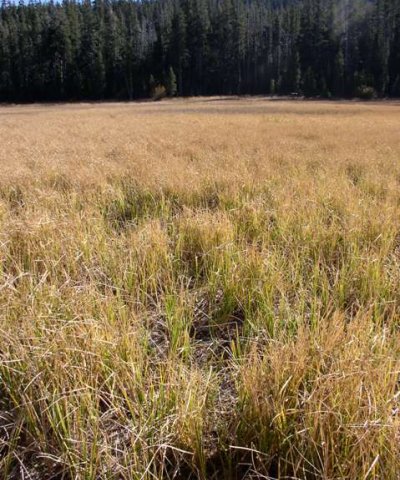
Figure 8. CC1
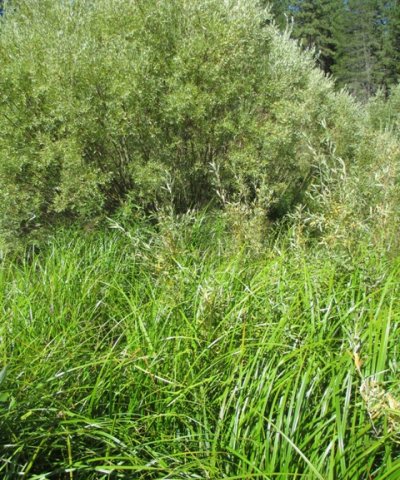
Figure 9. CC2
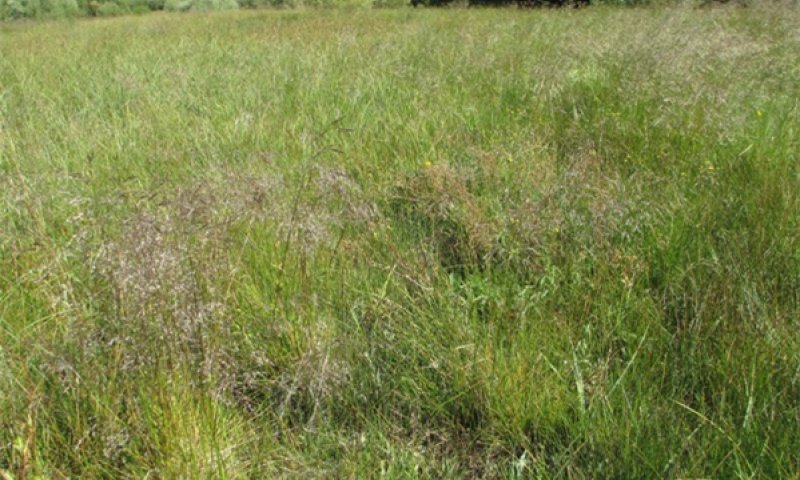
Figure 10. CC3
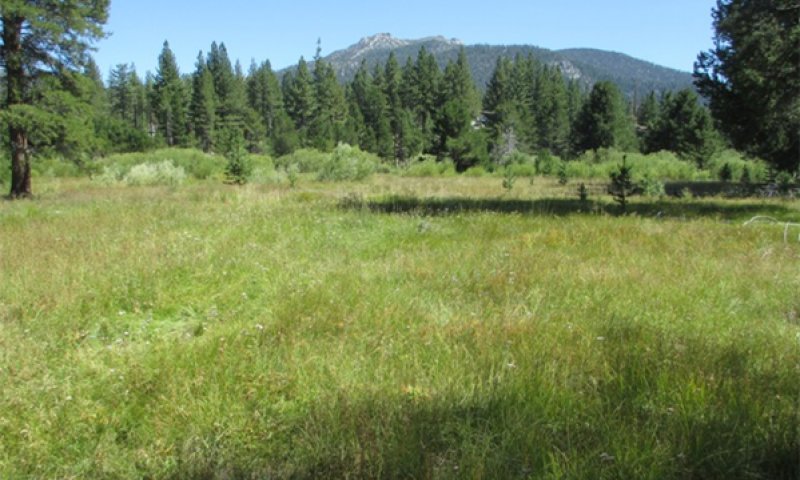
Figure 11. CC4
This phase is composed of a stable E type channel, with several community components present. There is a wide range of variability in this ecological site, and each area may have a unique plant community or variations in species composition. Only the dominant plant community and associated soil-landforms are described below as representative community components (CC#). CC1 Floodplains and depressions: This community is dominated by nearly pure stands of Northwest Territory sedge or blister sedge (Carex vesicaria). It occurs in wet depressions that have long durations of ponding, and a water table near the surface for most of the summer. Nebraska sedge, water sedge (Carex aquatilis), tufted hairgrass (Deschampsia cespitosa) and other species may be present in low amounts. CC2 Floodplains: This community occurs along the greenline of the channel, and on frequently flooded floodplains. This community has more flood activity than the ponding in CC1. It retains a water table near the surface throughout the summer in the wettest positions, but it is directly affected by fluctuations in the channel water level. Lemmon's willow and Geyer willow are dominant, with shining willow (Salix lucida) occasionally present. The understory has high cover and production of grass or grass-like species. Northwest Territory sedge, water sedge, and/or blister sedge are dominant. Nebraska sedge, bentgrass (Agrostis sp.), meadow barley (Hordeum brachyantherum), Mexican rush (Juncus mexicanus), mountain rush (Juncus arcticus ssp. littoralis) and panicled bulrush (Scirpus microcarpus) are common associates. Forbs are less abundant, but include common yarrow (Achillea millefolium), Pacific onion (Allium validum), Brewer's bittercress (Cardamine breweri), fringed willowherb (Epilobium ciliatum), threepetal bedstraw (Galium trifidum), largeleaf avens (Geum macrophyllum), wild mint (Mentha arvensis), seep monkeyflower (Mimulus guttatus), moving polemonium (Polemonium californicum), knotweed (Polygonum sp.), and Oregon checkerbloom (Sidalcea oregana ssp. spicata). CC3 Floodplain step, occasionally flooded: This community occurs on occasionally flooded and ponded floodplain steps. The water table may drop below 60 inches during the summer months. Tufted hairgrass and mountain rush are typically dominant with a mix of grass or grass-likes and forbs. Grass and grass-likes include water sedge, slenderbeak sedge (Carex athrostachya), Nebraska sedge, Northwest Territory sedge, spikerush (Eleocharis sp.), slender wheatgrass (Elymus trachycaulus), Mexican rush, pullup muhly (Muhlenbergia filiformis) and straightleaf rush (Juncus orthophyllus). Common forbs include common yarrow, Chamisso arnica (Arnica chamissonis), fringed willowherb (Epilobium ciliatum), Virginia strawberry (Fragaria virginiana), threepetal bedstraw, largeleaf avens, slender cinquefoil (Potentilla gracilis), and Oregon checkerbloom (Sidalcea oregana ssp. spicata). CC4 Outwash, occasionally flooded: This community occurs on outwash typically on the meadow edge, or raised islands within the meadow. The soils lack the rich organic surface, and indicators of the water table begin at 14 inches. Kentucky bluegrass (Poa pratensis), a grass not native to this area, is the most abundant understory species. Other grass and grass-like species include mountain rush, slender wheatgrass, blue wildrye (Elymus glaucus) and straightleaf rush. Forb composition is similar to CC3, but forbs are more productive in this community. Common forbs include slender cinquefoil (Potentilla gracilis), Virginia strawberry, threepetal bedstraw, groundsmoke (Gayophytum sp.), longspur lupine (Lupinus arbustus), Rydberg's penstemon (Penstemon rydbergii), meadow bistort (Polygonum bistorta), garden sorrel (Rumex acetosa), longleaf starwort (Stellaria longifolia), western mountain aster (Symphyotrichum spathulatum), and longstalk clover (Trifolium longipes).
Figure 12. Annual production by plant type (representative values) or group (midpoint values)
Table 5. Annual production by plant type
| Plant type | Low (kg/hectare) |
Representative value (kg/hectare) |
High (kg/hectare) |
|---|---|---|---|
| Grass/Grasslike | 785 | 2802 | 3923 |
| Shrub/Vine | 280 | 897 | 1681 |
| Forb | 11 | 224 | 336 |
| Tree | – | – | 112 |
| Total | 1076 | 3923 | 6052 |
Community 1.2
C Channel
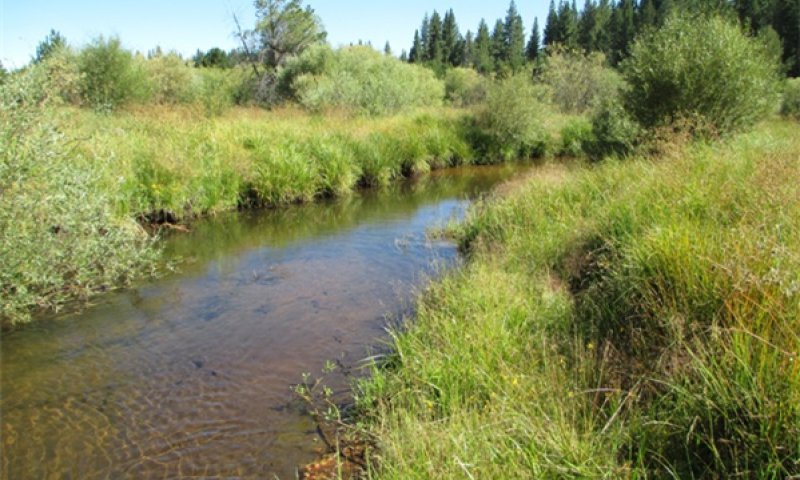
Figure 13. C Channel
The C type channel has similar community components and community composition as described in the E type channel phase, but the channel is wide and shallow. The change in channel morphology may be caused by a beaver activity, logs, root wads, or other channel obstructions, or natural changes in channel gradient or sinuosity.
Pathway 1.1a
Community 1.1 to 1.2


This pathway occurs with a pulse in sedimentation, and/ or channel disruptions (such as tree fall or beaver activity).
Pathway 1.2a
Community 1.2 to 1.1


This pathway occurs with increased channel stability, primarily from rhizomotous sedges, that allow the channel to develop deep undercut banks and an E type channel.
State 2
Entrenched Channel
This state is an unstable, entrenched state with G and F type channel types.
Community 2.1
G Channel
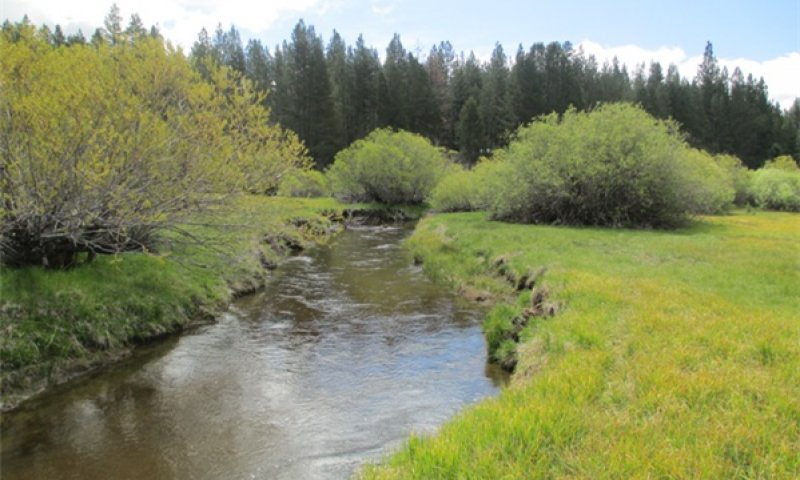
Figure 14. G Channel
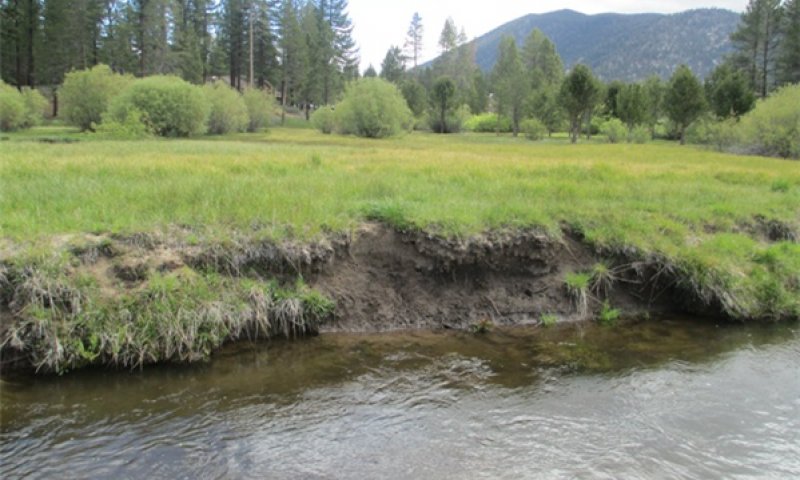
Figure 15. G Channel erosion
This phase is distinguished by a narrow, deeply incised G type channel. Stream banks are nearly vertical, with active slumping and erosion. The water level of the stream has incised 3 to 6 feet from the original elevation, causing the water table to drop throughout the meadow. The community components dependent upon frequent flooding, long durations of ponding and high water tables (CC1 and CC2) decline, and the vegetation shifts to drier upland species. CC1 Floodplains and depressions: Northwest Territory sedge and blister sedge will decline over time if water tables remain below 2 feet throughout the year. Typically this community will persist for some time, since it is in the lowest, wettest positions that may still be close enough to the water table. However as the site dries out, production and cover decline as shorter less robust plants develop. Other grass and grass-likes, less dependent upon a permanent high water table such as Nebraska sedge, Mexican rush, and mountain rush may increase. As bare ground increases, pioneer forbs establish. CC2b Floodplains: This community responds dramatically to channel incision and back erosion. Species dependent upon high water levels, such as Northwest Territory sedge, water sedge, blister sedge, widefruit sedge, and panicled bulrush are nearly eliminated, except in low positions or small lower benches in the channel. Lemmon's willow and Geyer willow persist without a measurable decline. Nebraska sedge is more tolerant of fluctuating water tables, increases after release from grazing, and is often dominant with willows along the incised channels. Forbs and grasses from CC3 and CC4 increase in this former active floodplain. Common yarrow, Chamisso arnica, western mountain aster, tufted hairgrass, Mexican rush, Rhyberg’s penstemon, meadow barley, Oregon checkerbloom, slender cinquefoil, Woods rose, mountain rush, Sierra lodgepole pine and Kentucky blue grass may be present in this altered community component. CC3b Floodplain step, occasionally flooded: This community maintains similar species as State 1 CC3, but overall cover and production declines. Tufted hairgrass flowering stalks may be over 3 feet tall in state 1, and 1 to 2 feet tall in this altered phase of CC3b. Mountain rush and forbs increase in dominance. Common yarrow, Chamisso arnica, Virginia strawberry, slender cinquefoil (Potentilla gracilis), Rhyberg’s penstemon and Oregon checkerbloom (Sidalcea oregana ssp. spicata) are common. Kentucky bluegrass and Sierra lodgepole pine often increase. CC4 Outwash, occasionally flooded: This community increases into the former floodplains as water tables drop and flood disturbances are reduced. Production of Kentucky blue grass may decline with lower water tables. Sierra lodgepole pine cover may increase from a few scattered trees to a dense forest. Jeffrey pine and white fir (Abies concolor) may also establish.
Community 2.2
F Channel
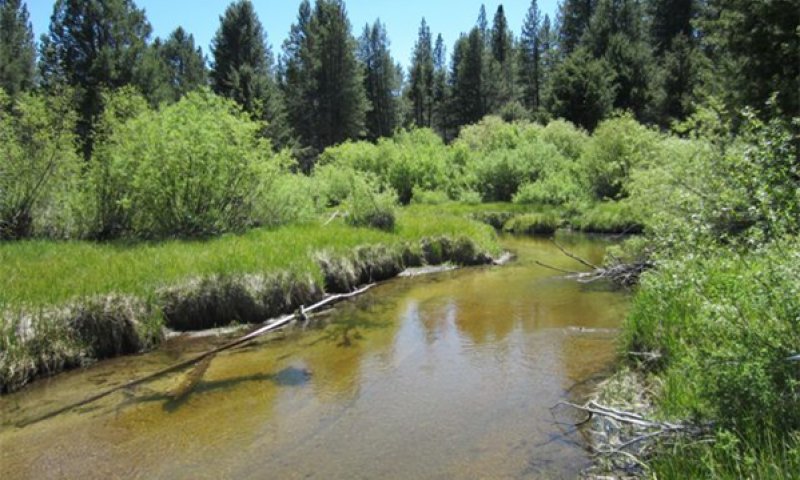
Figure 16. F Channel
The F type channel is wide, shallow and incised, with unstable actively eroding banks. Community components and community composition is similar as describe in the G type channel phase. The wider channel and lack of vegetation on the banks causes an exposed stream with little shade. Silt and sand from actively eroding banks cause a decline in habitat quality for fish and aquatic insects.
Pathway 2.1a
Community 2.1 to 2.2


This pathway develops as sedimentation and bank erosion continues to widen the channel forming, an F type channel.
State 3
Re-established Floodplain
This state is defined by entrenched C or E type channel.
Community 3.1
C Channel entrenched
Only the initial stages of an entrenched C channel were observed. Point bars, and lower floodplains have developed in some areas within F type channels. As the floodplains develop, there will be a new narrow floodplain that can support the water table dependent species in CC1 and CC2. However, these communities will persist at a much lower extent than prior to channel incision. CC2b, CC3b, and CC4 will remain on the upper abandoned floodplains.
Community 3.2
E Channel entrenched
The entrenched E channel resembles the original E type channel, but still remains disconnected from the original floodplain. Northwest Territory Sedge, blister sedge, and water sedge will continue to develop and increase in cover and density along the channel. CC2b, CC3b, and CC4 remain dominant on the abandoned floodplain.
Pathway 3.1a
Community 3.1 to 3.2
This pathway is initiated with the development of a deep and narrow E type channel. The development of dense rhizomatous sedge roots has a very high influence on E type channel development.
Pathway 3.2a
Community 3.2 to 3.1
The E type channel may widen, and develop a C channel due to natural or human influenced disturbances. Beaver dams often widen the channel below the dam. Logs or root wads in the channel may cause deflection of flow, causing bank erosion. Channel manipulations such as road diversions, and realignments can alter the channel morphology.
Transition 1A
State 1 to 2
This transition occurs when the E and C type channel equilibrium is disrupted. This may be triggered by the loss of channel stabilizing vegetation, either from physical trampling or hydrological alterations that cause the water table to lower and subsequently cause a decline in the stabilizing vegetation. Manipulations such as channel straightening, confining the floodplain, or improperly designed road crossings can also trigger this transition.
Restoration pathway 2.1A
State 2 to 1
Restoration to State 1 varies depending upon local site conditions. Stream reconstruction projects have been implemented in reaches of this ecological site. Stream meander was increased, channel bed raised, and E or C type channels were reconstructed. The restoration efforts have been successful in terms of creating a stable channel, and reconnecting the floodplain. See 2nd Nature's (, 2010) report for restoration on a reach of Trout Creek, and the propossed Truckee Marsh restoration EIR (Aecom and Entrix, 2013), which may include some of this ecological site. There are many other restoration projects that have been completed or are being planned.
Transition 2A
State 2 to 3
This transition occurs when the F channel has widened sufficiently to allow for a C channel type to develop with a lower re-established floodplain.
Restoration pathway 3.1A
State 3 to 1
Restoration from this state to state 1 would be similar R2A. Please refer to information in R2A pathway.
Additional community tables
Table 6. Community 1.1 plant community composition
| Group | Common name | Symbol | Scientific name | Annual production (kg/hectare) | Foliar cover (%) | |
|---|---|---|---|---|---|---|
|
Grass/Grasslike
|
||||||
| 1 | Floodplain and depressions | 1121–2802 | ||||
| Northwest Territory sedge | CAUT | Carex utriculata | 1121–2018 | 60–80 | ||
| Nebraska sedge | CANE2 | Carex nebrascensis | 0–336 | 0–5 | ||
| sedge | CAREX | Carex | 6–336 | 1–5 | ||
| tufted hairgrass | DECE | Deschampsia cespitosa | 0–56 | 0–1 | ||
| 2 | Floodplain | 1681–3923 | ||||
| Northwest Territory sedge | CAUT | Carex utriculata | 897–3138 | 12–70 | ||
| water sedge | CAAQ | Carex aquatilis | 11–2556 | 0–25 | ||
| panicled bulrush | SCMI2 | Scirpus microcarpus | 11–224 | 1–3 | ||
| mountain rush | JUARL | Juncus arcticus ssp. littoralis | 0–56 | 0–2 | ||
| tufted hairgrass | DECE | Deschampsia cespitosa | 0–22 | 0–3 | ||
| meadow barley | HOBR2 | Hordeum brachyantherum | 0–6 | 0–1 | ||
| blister sedge | CAVE6 | Carex vesicaria | 0–6 | 0–1 | ||
| Mexican rush | JUME4 | Juncus mexicanus | 0–6 | 0–1 | ||
| bentgrass | AGROS2 | Agrostis | 0–6 | 0–1 | ||
| 3 | Floodplain step, occasionally flooded | 1681–3026 | ||||
| tufted hairgrass | DECE | Deschampsia cespitosa | 785–1345 | 15–35 | ||
| mountain rush | JUARL | Juncus arcticus ssp. littoralis | 6–807 | 1–20 | ||
| spikerush | ELEOC | Eleocharis | 6–594 | 1–8 | ||
| Mexican rush | JUME4 | Juncus mexicanus | 0–224 | 0–8 | ||
| straightleaf rush | JUOR | Juncus orthophyllus | 6–168 | 1–5 | ||
| water sedge | CAAQ | Carex aquatilis | 0–112 | 1–5 | ||
| slenderbeak sedge | CAAT3 | Carex athrostachya | 0–78 | 0–2 | ||
| slender wheatgrass | ELTR7 | Elymus trachycaulus | 0–78 | 0–2 | ||
| Nebraska sedge | CANE2 | Carex nebrascensis | 0–56 | 0–2 | ||
| Northwest Territory sedge | CAUT | Carex utriculata | 0–56 | 0–2 | ||
| pullup muhly | MUFI2 | Muhlenbergia filiformis | 1–22 | 1–5 | ||
| 4 | Outwash, meadow edge | 785–1121 | ||||
| mountain rush | JUARL | Juncus arcticus ssp. littoralis | 0–560 | 0–10 | ||
| Kentucky bluegrass | POPR | Poa pratensis | 39–78 | 400–800 | ||
| blue wildrye | ELGL | Elymus glaucus | 0–56 | 0–3 | ||
| bentgrass | AGROS2 | Agrostis | 0–56 | 0–3 | ||
| straightleaf rush | JUOR | Juncus orthophyllus | 0–22 | 0–2 | ||
| water sedge | CAAQ | Carex aquatilis | 0–22 | 0–1 | ||
| slender wheatgrass | ELTR7 | Elymus trachycaulus | 0–11 | 0–1 | ||
|
Shrub/Vine
|
||||||
| 2 | Floodplain | 280–1681 | ||||
| Lemmon's willow | SALE | Salix lemmonii | 112–1121 | 2–15 | ||
| Geyer willow | SAGE2 | Salix geyeriana | 168–560 | 3–9 | ||
| shining willow | SALU | Salix lucida | 0–168 | 0–1 | ||
| whitestem gooseberry | RIINI | Ribes inerme var. inerme | 3–56 | 0–1 | ||
| 4 | Outwash, meadow edge | 0–168 | ||||
| Lemmon's willow | SALE | Salix lemmonii | 0–168 | 0–2 | ||
| Woods' rose | ROWOU | Rosa woodsii var. ultramontana | 0–56 | 0–1 | ||
|
Forb
|
||||||
| 2 | Floodplain | 45–336 | ||||
| wild mint | MEAR4 | Mentha arvensis | 1–224 | 0–2 | ||
| largeleaf avens | GEMA4 | Geum macrophyllum | 6–84 | 1–5 | ||
| fringed willowherb | EPCI | Epilobium ciliatum | 0–6 | 0–2 | ||
| threepetal bedstraw | GATR2 | Galium trifidum | 0–6 | 0–1 | ||
| common yarrow | ACMI2 | Achillea millefolium | 0–6 | 0–1 | ||
| seep monkeyflower | MIGU | Mimulus guttatus | 0–6 | 0–1 | ||
| moving polemonium | POCA3 | Polemonium californicum | 1–6 | 0–1 | ||
| Brewer's bittercress | CABR6 | Cardamine breweri | 0–6 | 0–1 | ||
| Oregon checkerbloom | SIORS | Sidalcea oregana ssp. spicata | 0–6 | 0–1 | ||
| Pacific onion | ALVA | Allium validum | 0–1 | 0–10 | ||
| knotweed | POLYG4 | Polygonum | 0–1 | 0–1 | ||
| 3 | Floodplain step, occasionally flooded | 11–84 | ||||
| largeleaf avens | GEMA4 | Geum macrophyllum | 0–34 | 0–3 | ||
| slender cinquefoil | POGR9 | Potentilla gracilis | 0–11 | 0–1 | ||
| Oregon checkerbloom | SIORS | Sidalcea oregana ssp. spicata | 0–11 | 0–1 | ||
| Chamisso arnica | ARCH3 | Arnica chamissonis | 0–11 | 0–1 | ||
| Virginia strawberry | FRVI | Fragaria virginiana | 0–11 | 0–1 | ||
| threepetal bedstraw | GATR2 | Galium trifidum | 0–6 | 0–1 | ||
| fringed willowherb | EPCI | Epilobium ciliatum | 0–6 | 0–1 | ||
| common yarrow | ACMI2 | Achillea millefolium | 0–6 | 0–1 | ||
| 4 | Outwash, meadow edge | 11–336 | ||||
| slender cinquefoil | POGR9 | Potentilla gracilis | 11–224 | 1–8 | ||
| garden sorrel | RUAC2 | Rumex acetosa | 0–56 | 0–3 | ||
| western mountain aster | SYSP | Symphyotrichum spathulatum | 0–11 | 0–1 | ||
| Virginia strawberry | FRVI | Fragaria virginiana | 0–11 | 0–1 | ||
| longspur lupine | LUAR6 | Lupinus arbustus | 0–11 | 0–1 | ||
| Rydberg's penstemon | PERY | Penstemon rydbergii | 0–11 | 0–1 | ||
| meadow bistort | POBI5 | Polygonum bistorta | 0–11 | 0–1 | ||
| Douglas' knotweed | PODO4 | Polygonum douglasii | 0–6 | 0–1 | ||
| threepetal bedstraw | GATR2 | Galium trifidum | 0–6 | 0–1 | ||
| groundsmoke | GAYOP | Gayophytum | 0–6 | 0–1 | ||
| longstalk clover | TRLO | Trifolium longipes | 0–6 | 0–1 | ||
| longleaf starwort | STLO | Stellaria longifolia | 0–6 | 0–1 | ||
|
Tree
|
||||||
| 4 | Outwash, meadow edge | 0–112 | ||||
| Sierra lodgepole pine | PICOM | Pinus contorta var. murrayana | 0–112 | 0–5 | ||
| Jeffrey pine | PIJE | Pinus jeffreyi | 0–22 | 0–1 | ||
Interpretations
Animal community
This site provides critical habitat for several species of birds. This site provides prime habitat for beaver. Deer, bear, and coyotes, use this area as well. This site can provide high quality habitat for fish and aquatic insects.
Hydrological functions
The hydrology of this site influenced primarily by the spring snowmelt. This ecological site provides for water catchment, sediment and nutrient storage when in good condition (State 1). It is a source for sediment and nutrients, when in poor condition (State 2).
Recreational uses
This area was used in the past for grazing cattle and horses. Trails should be designed so they do not compact the soils or alter surface flow. This site provides open vistas for wildlife and wildflower viewing.
Wood products
Not applicable.
Supporting information
Inventory data references
The following NRCS plots were used to describe this ecological site.
State 1
Phase 1
062 (CC1)
062b (CC2)
062c (CC3)
Lo03088 (CC4)
lo03089 (CC1)
Lo03090 (CC1)
TC_XC1_CC1
TC_XC1_CC2
TC_XC1_CC3
State 2
lo02 Tahoe soil type location (TC_L_XC1 and TC_L_XC2
Lo0200
Lo02019
Lo02020
Lo02679
Lo02680
Lo02681
Lo02682
Lo02WP4
Lo04016Tr1Plot1
Lo04016Tr1Plot10
Lo04016Tr1Plot11
Lo04016Tr1Plot2
Lo04016Tr1Plot3
Lo04016Tr1Plot4
Lo04016Tr1Plot5
Lo04016Tr1Plot6
Lo04016Tr1Plot7
Lo04016Tr1Plot8
Lo04016Tr1Plot9
Lo04017Tr2Plot1
Lo04017Tr2Plot2
Lo04017Tr2Plot3
Lo04017Tr2Plot4
Lo04017Tr2Plot5
Lo04017Tr2Plot6
Lo04017Tr2Plot7
mh02539
Mh02683
Mh02684
Mh02686
TC_XS_3
Type locality
| Location 1: El Dorado County, CA | |
|---|---|
| UTM zone | N |
| UTM northing | 4312035 |
| UTM easting | 242311 |
| General legal description | Near Trout Creek, behind Pump Station. |
Other references
2nd Nature. 2010. Quantification + Characterization of Trout Creek Restoration Effectiveness.
Allen-Diaz, Barbara H. 1991. Water Table and Plant Species Relationships in Sierra Nevada Meadows. American Midland Naturalist, Vol. 126, No. 1 (Jul., 1991), pp. 30-43. Currently published by University of Notre Dame.
AECOM, and C. ENTRIX. 2013. Upper Truckee River and Marsh Restoration Project (EIR).in C. T. Conservancy, editor.
Beier, P., and R. H. Barrett. 1987. Beaver habitat use and impact in Truckee River Basin, California. Journal of Wildlife Management 51:794-799.
Castelli, Regine M.; Chambers, Jeanne C.; and Tausch, Robin J. 2000. Soil-Plant Relations Along a Soil-Water Gradient in Great Basin Riparian Meadows. Wetlands, Vol. 20, No. 2, June 2000, pp. 251-266. The Society of Wetland Scientist.
Cowardin, L.M.; Carter, V.; Golet, F.C.; LaRoe, E.T. 1979. Classification of Wetlands and Deepwater Habitats of the United States. U.S. Fish and Wildlife Service Report No. FWS/OBS/-79/31.Washington, D.C.
Davis, O. K. 1996. Pollen Analysis of a Mid-Lake Core from Lake Tahoe, California: Historic Vegetation Change. Sierra Nevada Ecosystem Project: Final report to Congress, Addendum.
Dwire, Kathleen A.; Kaufmann, Boone J.; and Baham, John E. 2006. Plant Species Distribution in relation to Water-Table Depth and Soil Redox Potential in Montane Riparian Meadows. Wetlands, Vol 26, No.1, March 2006, pp. 131-146. The Society of Wetland Scientist.
Elliott-Fisk, D. L., T. A. Cahill, O. K. Davis, L. Duan, C. R. Goldman, G. E. Gruell, R. Harris, R. Kattelmann, R. Lacey, D. Leisz, S. Lindstrom, D. Machida, R. A. Rowntree, P. Rucks, D. A. Sharkey, S. L. Stephens, and D. S. Ziegler. 1996. Tahoe Case Study. Sierra Nevada Ecosystem Project: Final Report to Congress.
James, C. D., and R. B. Lanman. 2012. Novel physical evidence that beaver historically were native to the Sierra Nevada. California Fish and Game 98:129-132.
Kie, J. G., and B. B. Boroski. 1996. Cattle distribution, habitats, and diets in the Sierra Nevada of California. Journal of Range Management 49:482-488.
Lahontan Water Board, and Nevada Division of Environmental Protection. 2008. Charting the Course to Clarity.
Landman, R., H. Perryman, D. Brock, and C. D. James. 2012. The historical range of beaver in the Sierra Nevada: a review of the evidence. California Fish and Game 98:65 to 80.
Martin, David, W. and Chambers, Jeanne C. 2001. Effects of Water Table, Clipping, and Species Interactions on Carex nebrascensis and Poa pratensis in Riparian Meadows. Wetlands, Vol. 21, N0. 3, September 2001, pp. 422-430. The Society of Wetland Scientist.
Muskopf, S. 2007. The effect of beaver (Castor canadensis) dam removal on total phosphorus
concentration in Taylor Creek and Wetland, South Lake Tahoe, California. . Natural Resources M.S.:35.
Rosgen, D. L. 1996. Applied river morphology. Wildland Hydrology, Pagosa Springs, CO
Rosgen, D. L. 1997. A Geomorphological Approach to Restoration of Incised Rivers in Proceedings of the Conference on Management of Landscapes Disturbed by Channel Incision.
Uchytil, Ronald J. 1989. Salix lemmonii. In: Fire Effects Information System, [Online]. U.S. Department of Agriculture, Forest Service, Rocky Mountain Research Station, Fire Sciences Laboratory (Producer). Available: http://www.fs.fed.us/database/feis/ [2007, January 26].
Weixelman, Dave A.; Zamudio, Desiderio C.; and Tausch,Robin J. 1997. Classifying Ecological Types and Evaluating Site Degradation. Journal of Range Management. 50(3).
Weixelman, Dave A.; Zamudio, Desiderio C.; and Zamudio, Karen A., 1999. Eastern Sierra Nevada Riparian Field Guide. USDA, Forest Service, Intermountain Region, R4-ECOL-99-01.
Contributors
Marchel Munnecke
Rangeland health reference sheet
Interpreting Indicators of Rangeland Health is a qualitative assessment protocol used to determine ecosystem condition based on benchmark characteristics described in the Reference Sheet. A suite of 17 (or more) indicators are typically considered in an assessment. The ecological site(s) representative of an assessment location must be known prior to applying the protocol and must be verified based on soils and climate. Current plant community cannot be used to identify the ecological site.
| Author(s)/participant(s) | |
|---|---|
| Contact for lead author | |
| Date | |
| Approved by | |
| Approval date | |
| Composition (Indicators 10 and 12) based on | Annual Production |
Indicators
-
Number and extent of rills:
-
Presence of water flow patterns:
-
Number and height of erosional pedestals or terracettes:
-
Bare ground from Ecological Site Description or other studies (rock, litter, lichen, moss, plant canopy are not bare ground):
-
Number of gullies and erosion associated with gullies:
-
Extent of wind scoured, blowouts and/or depositional areas:
-
Amount of litter movement (describe size and distance expected to travel):
-
Soil surface (top few mm) resistance to erosion (stability values are averages - most sites will show a range of values):
-
Soil surface structure and SOM content (include type of structure and A-horizon color and thickness):
-
Effect of community phase composition (relative proportion of different functional groups) and spatial distribution on infiltration and runoff:
-
Presence and thickness of compaction layer (usually none; describe soil profile features which may be mistaken for compaction on this site):
-
Functional/Structural Groups (list in order of descending dominance by above-ground annual-production or live foliar cover using symbols: >>, >, = to indicate much greater than, greater than, and equal to):
Dominant:
Sub-dominant:
Other:
Additional:
-
Amount of plant mortality and decadence (include which functional groups are expected to show mortality or decadence):
-
Average percent litter cover (%) and depth ( in):
-
Expected annual annual-production (this is TOTAL above-ground annual-production, not just forage annual-production):
-
Potential invasive (including noxious) species (native and non-native). List species which BOTH characterize degraded states and have the potential to become a dominant or co-dominant species on the ecological site if their future establishment and growth is not actively controlled by management interventions. Species that become dominant for only one to several years (e.g., short-term response to drought or wildfire) are not invasive plants. Note that unlike other indicators, we are describing what is NOT expected in the reference state for the ecological site:
-
Perennial plant reproductive capability:
Print Options
Sections
Font
Other
The Ecosystem Dynamics Interpretive Tool is an information system framework developed by the USDA-ARS Jornada Experimental Range, USDA Natural Resources Conservation Service, and New Mexico State University.
Click on box and path labels to scroll to the respective text.